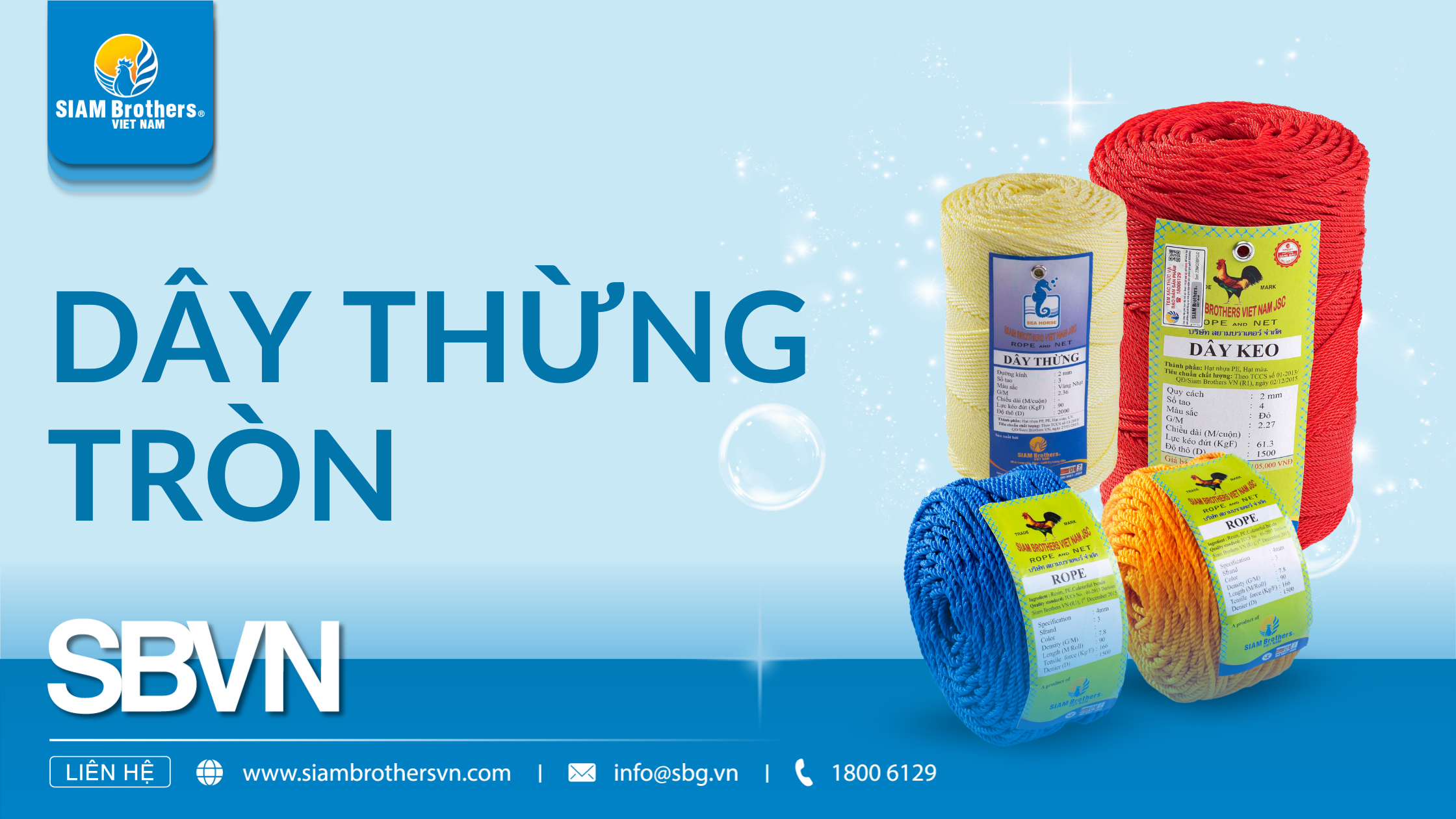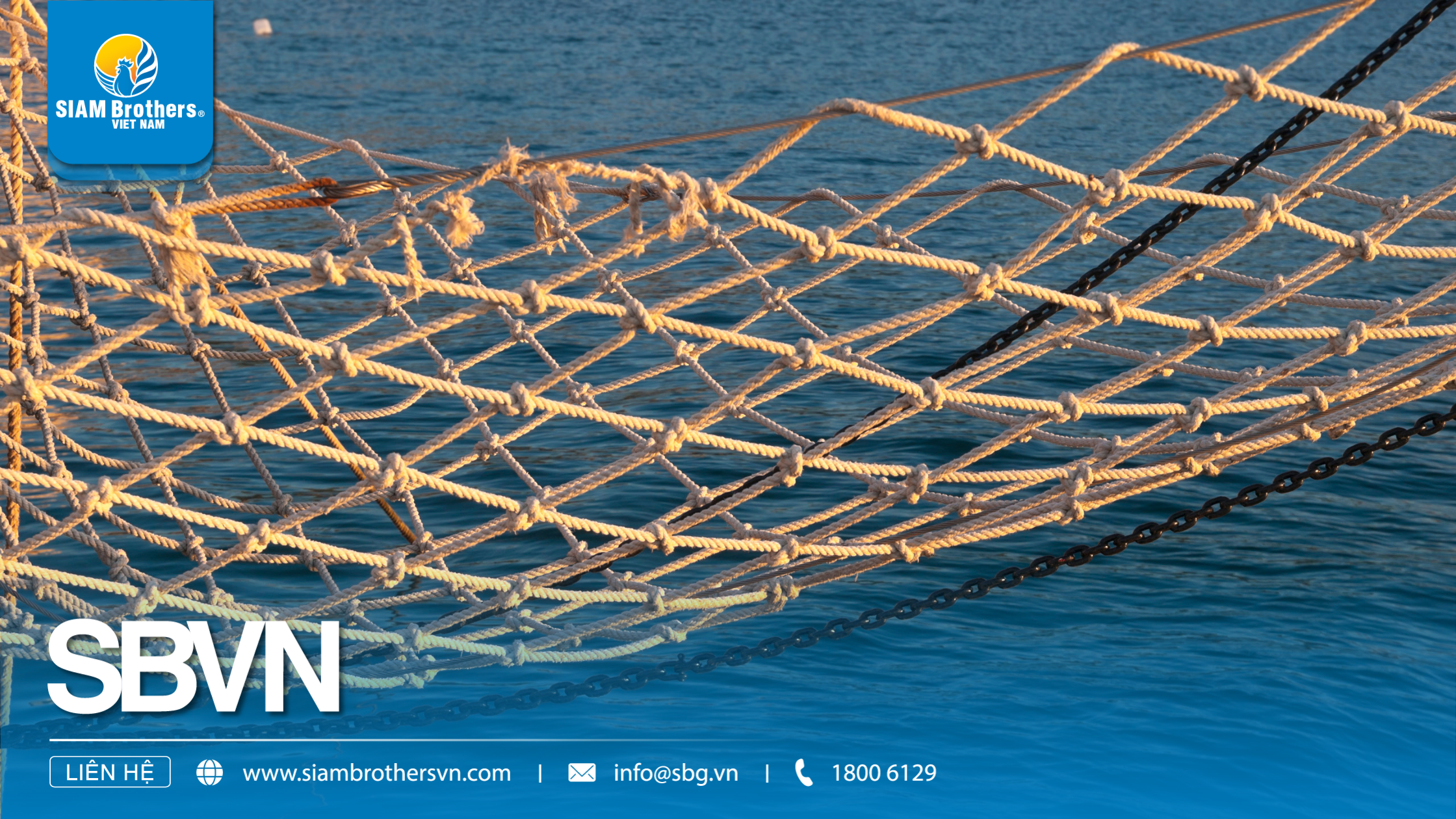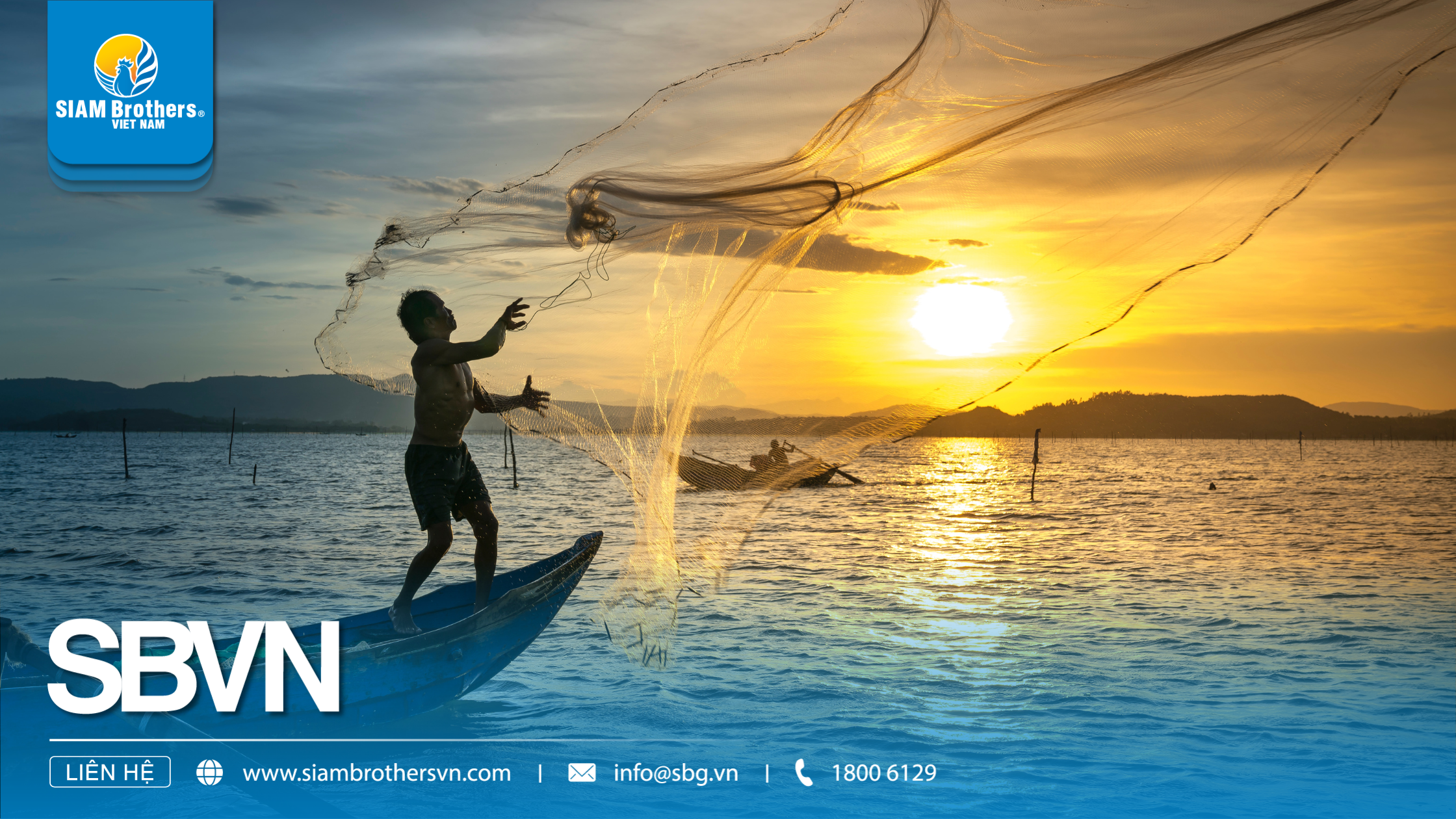A round rope might seem simple at first glance, but it plays a critical role in ensuring the safety of every offshore journey. In harsh saltwater environments with constant heavy loads and strong waves, choosing the right high-quality round rope not only helps fishing vessels operate efficiently but also protects equipment and crew members at sea. So, what are the key criteria to consider when purchasing round rope for fishing boats and vessels? In this article, SIAM Brothers Vietnam will guide you through the 5 core factors to help you make the most accurate and long-lasting choice for every trip offshore.
1. The Need & Importance of Round Rope for Fishing Vessels
Applications of Round Rope in the Fishing Industry
- Hauling heavy nets and anchoring large vessels: For high-capacity fishing boats, round ropes offer stable pulling force, reduce elongation, and prevent sudden breakage.
- Securing deck equipment: From cargo boxes and lifebuoys to fishing nets – everything needs to be tightly secured to avoid shifting during operation.
- Supporting anchoring and docking: Round ropes have evenly twisted structures with good abrasion resistance, ensuring stability even in rough waves.
- Flexible connections between components: Round ropes are easy to bend and knot, making them ideal for quick handling in marine environments.
 A round rope is not just a fastening tool – it directly impacts the operational efficiency and safety of every journey at sea - Source: SIAM Brothers Vietnam
A round rope is not just a fastening tool – it directly impacts the operational efficiency and safety of every journey at sea - Source: SIAM Brothers Vietnam
Importance in Harsh Marine Conditions
Unlike land-based equipment, marine ropes must withstand:
- Saltwater corrosion: Only high-grade round ropes maintain long-term durability.
- Sunlight and UV exposure: Cheap ropes can quickly become brittle and decay under prolonged sun exposure.
- Heavy loads and constant movement: Offshore fishing operations last for days, requiring ropes with reliable strength and elasticity.
Related products:
- Nylon Rope
- Plastic Rope
2. Criterion 1: Load Capacity and Tensile Strength of Round Rope
2.1 Risks of Choosing Low-Capacity Round Ropes
- Prone to snapping during heavy net hauling, leading to lost catch.
- Unsafe anchoring, especially during rough weather conditions.
- Frequent replacements increase maintenance and operation costs.
2.2 How to Identify Strong, Durable Round Ropes
Maximum Tensile Strength Rating:
- Measured in daN or kN.
- Ropes for fishing boats should typically exceed 1,000 daN, depending on the vessel size and load requirements.
Resistance to twisting and jerking: Ropes with uniform twisting and firm cores can handle sudden pulls without unraveling.
Material Composition for Stable Strength:
- PP (Polypropylene): Lightweight, floats on water, excellent tensile strength.
- PET (Polyester): High durability, minimal stretch, ideal for rough seas.
2.3 Expert Tips from SIAM Brothers Vietnam
- Choose certified ropes tested for tensile strength and manufactured to ISO or export standards.
- Select appropriate rope diameters: too thin = easy breakage, too thick = difficult handling.
- Refer to the load capacity chart by rope diameter to match actual usage needs.

Read more: What Makes Red Rope Special? Key Advantages & Real-Life Applications
3. Criteria 2: Rope Material – PP (Polypropylene) vs. PET (Polyester)
3.1 Comparing the Advantages of PP and PET Materials in Round Rope
Polypropylene (PP) – Lightweight, Buoyant, and Flexible
- Lightweight structure makes it easy to handle and move on fishing vessels.
- Naturally floats on water, making it ideal for fishing nets, buoys, and surface gear.
- Excellent resistance to chemicals and oil, suitable for marine environments.
- Cost-effective choice, especially for small to medium-sized fishing boats.
Polyester (PET) – Strong, UV-Resistant, and Durable
- High tensile strength and low stretch ensure stable net pulling and anchoring.
- Superior resistance to UV rays and heat, preventing brittleness under long sun exposure.
- Low water absorption helps maintain stable weight after prolonged soaking.
- Long lifespan, perfect for offshore fishing or intensive maritime operations.
3.2 Tips for Choosing Round Rope by Material
- Choose the material based on usage needs: net pulling, mooring, or equipment securing.
- Avoid ropes with unclear origin, as recycled synthetics can compromise safety.
- Always assess material in combination with tensile strength to ensure optimal performance and durability.
 Not all round ropes are created equal — the most critical difference lies in the material composition - Source: SIAM Brothers Vietnam
Not all round ropes are created equal — the most critical difference lies in the material composition - Source: SIAM Brothers Vietnam
Learn more: What Is Polyester Rope? A-Z Guide on Multi-Use Synthetic Rope
4. Criteria 3: Resistance to Saltwater, UV Rays and Mold
4.1 Why These Features Are Crucial for Round Rope at Sea
- Prolongs Rope Lifespan: Prevents degradation caused by salt corrosion and microorganisms.
- Maintains Mechanical Strength: Protects against cracking or brittleness from prolonged sun exposure.
- Reduces Mold and Odor: Ensures a cleaner work environment and avoids equipment contamination.
- Improves Fishing Efficiency: Prevents sagging or tearing after soaking or under heavy load.
4.2 Key Features of a Durable Marine-Grade Round Rope
UV Resistance
- Opt for ropes with UV stabilizers to prevent color fading and surface damage.
- PET or composite ropes naturally offer stronger UV resistance than standard PP ropes.
Saltwater Resistance
- Virgin polypropylene or premium-grade synthetics show better corrosion resistance.
- Tight-twist structure limits seawater penetration to the core.
Mold and Mildew Protection
- Ropes treated with antimicrobial agents prevent long-term moisture buildup.
- Ideal for boats that remain anchored for long periods or operate in humid climates.
4.3 Pro Tips from SIAM Brothers Vietnam
- Ask suppliers about UV/mold resistance certifications and material origin.
- Choose multi-layer UV-coated or composite ropes for offshore applications.
- Clean and air-dry ropes after use, even if they’re moisture-resistant, to extend lifespan.

5. Criteria 4: Firm Twist Construction and Core Integrity
5.1 Why Twist Design Matters in Round Rope
- Ensures consistent load distribution along the rope’s length.
- Prevents tangling or fiber fraying during high-tension use.
- Reduces core separation — a major cause of rope failure.
- Enhances flexibility for tying, pulling, and anchoring maneuvers.
5.2 How to Identify a Well-Twisted Round Rope
3- or 4-Strand Uniform Twist
- Strands should be tightly twisted in the same direction, forming strong cohesion.
- Even twist pattern improves tension absorption and minimizes breakage risk.
Compressed, Solid Core
- High-quality ropes feature a compressed core with no hollow gaps.
- A solid center maintains the rope’s shape and increases overall durability.
Smooth Surface Without Frays
- Touch should feel smooth yet firm, with no loose or fuzzy fibers.
- Frayed ropes tend to tangle easily and break unexpectedly under stress.
5.3 Tips for Choosing High-Quality Twisted Round Rope
- Choose trusted brands with in-house quality control like SIAM Brothers.
- Avoid loosely braided ropes with hollow cores or ones that unravel under tension.
- Select 3- or 4-strand twist based on load demands and usage context.

6. Criteria 5: Origin, Quality Certifications, and Reputable Manufacturer
6.1 Why Are Origin and Certifications So Important?
- Ensure the rope is made from the correct material and meets the published technical specifications.
- Guarantee safety and durability when used in harsh marine environments.
- Provide full traceability from raw materials to final quality control.
- Reduce the risk of purchasing counterfeit or low-quality round rope with unclear origins.
6.2 What to Check Before Buying Round Rope
International and Local Quality Certifications
- Look for certifications such as ISO 9001, SGS, and TCVN.
- Certified for tensile strength, UV resistance, and saltwater protection—suitable for marine applications.
Transparent Manufacturer Information
- Manufacturer should have an official website and a clear business address.
- A proven track record of supplying the fishing and agricultural industries.
- Trusted by major commercial fleets and industry leaders.
Traceable Product Origin
- Each coil of rope should feature a product code and batch number.
- Source verification available through QR code or electronic invoice.
- This is especially crucial for warranty purposes or when comparing specs across different batches.
6.3 Expert Advice from the Rope Industry
- Choose manufacturers with in-house production facilities and closed-loop processes like SIAM Brothers Vietnam, a trusted name in the rope industry for over 30 years.
- Avoid purchasing unbranded rope with no labels or certifications.
- Whenever possible, request tensile strength and durability test reports—especially when sourcing round rope for offshore or high-stress applications.

Selecting the right round rope for fishing boats or small vessels is not just about finding the cheapest product. It’s a strategic decision that directly impacts crew safety, operational efficiency, and the longevity of your vessel throughout extended journeys.
By considering five essential criteria—tensile strength, rope material, resistance to saltwater and UV rays, tight-twist construction, and manufacturer credibility—you gain the confidence to choose high-performance, reliable round rope that meets your needs. If you're looking for a trusted supplier of high-quality round rope, don’t hesitate to contact SIAM Brothers Vietnam—a leading manufacturer of specialized ropes for the fishing industry, known for exceptional quality and durability.
Source: SIAM Brothers Vietnam
Contact us:
Address: 5th floor, VRG Building, 177 Hai Ba Trung Str., Vo Thi Sau Ward, Disc. 12, Ho Chi Minh City, Vietnam
Tel: (+84) 28 38 912 889
Hotline: 1800 6129
Facebook: www.facebook.com/siambrothersvn
Email: info@sbg.vn
Youtube: youtube.com/@siambrothersvietnam1728
X: x.com/sbvnjsc
OA Zalo: zalo.me/1402339229697925373
App SBVN ID:

 A round rope is not just a fastening tool – it directly impacts the operational efficiency and safety of every journey at sea - Source: SIAM Brothers Vietnam
A round rope is not just a fastening tool – it directly impacts the operational efficiency and safety of every journey at sea - Source: SIAM Brothers Vietnam
 Not all round ropes are created equal — the most critical difference lies in the material composition - Source: SIAM Brothers Vietnam
Not all round ropes are created equal — the most critical difference lies in the material composition - Source: SIAM Brothers Vietnam


